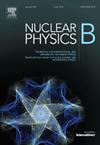广义时间平移不变性的物理老化
IF 2.5
3区 物理与天体物理
Q2 PHYSICS, PARTICLES & FIELDS
引用次数: 0
摘要
时间平移不变性的广义形式允许重新导出已知的老化的一般现象学,它出现在经典多体系统中,从最初的无序系统淬火到温度T≤Tc,等于或低于临界温度Tc。从尺度不变性和时间不变性动态对称的李代数生成子的表示变化出发,得到了广义的时间平移不变性。可观察到的结果包括双时间自相关器和自响应的大参数标度函数的代数形式,自相关和自响应指数λC=λR的等式,初始磁化临界系统的交叉标度形式,以及当自相关器或自响应在大参数y=t/s≠1收敛到平台时新的有限尺寸标度的解释。对于全局双时间相关器,涉及初始临界滑移指数Θ的时间依赖性得到确认,并推广到临界以下的所有温度和全局双时间响应函数,并且推导了它们的有限尺寸缩放。这还包括全局序参数平方的时间依赖性。具有自相关指数的著名的Janssen-Schaub-Schmittmann标度关系由此扩展到低于临界温度的所有温度。在考虑耦合维数的情况下,导出了随机运动方程中非线性项相关性的一个简单准则。对于温度T≤Tc的情况,证实了其在广泛的模型类别中的适用性。并讨论了与实验的相关性。本文章由计算机程序翻译,如有差异,请以英文原文为准。
Physical ageing from generalised time-translation-invariance
A generalised form of time-translation-invariance permits to re-derive the known generic phenomenology of ageing, which arises in classical many-body systems after a quench from an initially disordered system to a temperature , at or below the critical temperature . Generalised time-translation-invariance is obtained, out of equilibrium, from a change of representation of the Lie algebra generators of the dynamical symmetries of scale-invariance and time-translation-invariance. Observable consequences include the algebraic form of the scaling functions for large arguments of the two-time auto-correlators and auto-responses, the equality of the auto-correlation and the auto-response exponents , the cross-over scaling form for an initially magnetised critical system and the explanation of a novel finite-size scaling if the auto-correlator or auto-response converge for large arguments to a plateau. For global two-time correlators, the time-dependence involving the initial critical slip exponent Θ is confirmed and is generalised to all temperatures below criticality and to the global two-time response function, and their finite-size scaling is derived as well. This also includes the time-dependence of the squared global order-parameter. The celebrate Janssen-Schaub-Schmittmann scaling relation with the auto-correlation exponent is thereby extended to all temperatures below the critical temperature. A simple criterion on the relevance of non-linear terms in the stochastic equation of motion is derived, taking the dimensionality of couplings into account. Its applicability in a wide class of models is confirmed, for temperatures . Relevance to experiments is also discussed.
求助全文
通过发布文献求助,成功后即可免费获取论文全文。
去求助
来源期刊

Nuclear Physics B
物理-物理:粒子与场物理
CiteScore
5.50
自引率
7.10%
发文量
302
审稿时长
1 months
期刊介绍:
Nuclear Physics B focuses on the domain of high energy physics, quantum field theory, statistical systems, and mathematical physics, and includes four main sections: high energy physics - phenomenology, high energy physics - theory, high energy physics - experiment, and quantum field theory, statistical systems, and mathematical physics. The emphasis is on original research papers (Frontiers Articles or Full Length Articles), but Review Articles are also welcome.
 求助内容:
求助内容: 应助结果提醒方式:
应助结果提醒方式:


